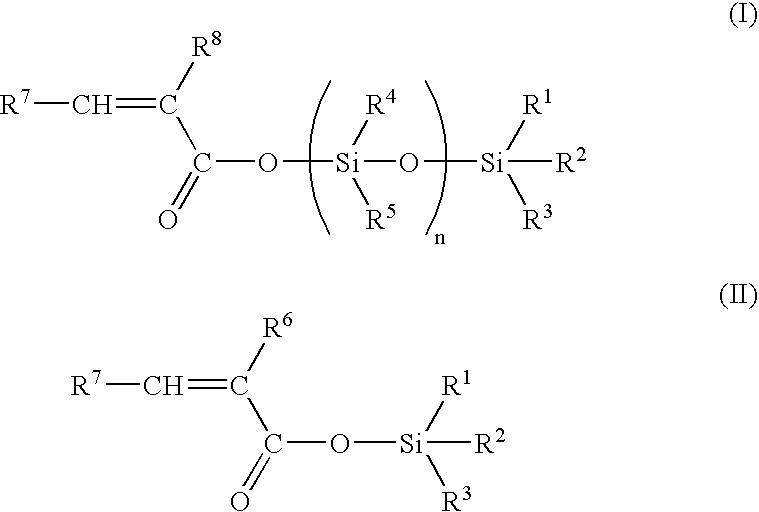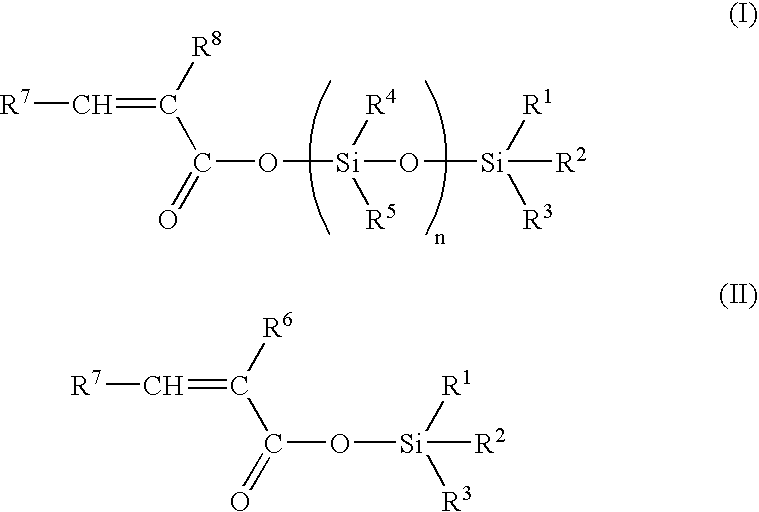Process for the preparation of polyorganosilylated carboxylate monomers or polymers thereof
a technology of organic carboxylate and monomers, which is applied in the field of preparation of polyorganosilylated carboxylate monomers or polymers, can solve the problems of reducing the speed of the ship and subsequently increasing the fuel consumption, reducing the lifetime of the underwater structure, and requiring a long period of working time to remove aquatic organisms from the ship's bottom. , the effect of reducing the number of toxic substances
- Summary
- Abstract
- Description
- Claims
- Application Information
AI Technical Summary
Benefits of technology
Problems solved by technology
Method used
Image
Examples
example 1
[0058] 50 g of hexamethylcyclotrisiloxane, 35.6 g of trimethylsilyl methacrylate, 2.5 g of zinc chloride and 0.4 g of 4-methoxy phenol were dissolved in 50 ml of toluene. After 11 h at 100° C., the mixture was allowed to cool until room temperature, 40 ml of triethylamine were then added and the salts were filtered. After evaporation of the solvent, distillation under reduced pressure (0.3 mbar, 80° C.) furnished pure nonamethyl-1-methacryloyloxy-tetrasiloxane.
[0059]13C NMR: 167.0, 137.7, 126.4, 18.5, 2.0, 1.3,1.1, 0. 0;
[0060]29Si NMR: 7.3,-8.6, -20.1,-21. 0;
[0061] IR (film): 2963,1707, 1638,1335, 1310,1261, 1179,1082, 1044,842, 804 cm−1.
example 2
[0062] 5 g of hexamethylcyclotrisiloxane, 3.5 g of trimethylsilyl methacrylate, 0.016 g of trifluoromethane sulfonic acid were stirred for 24 h at room temperature. 0.5 ml of triethylamine was then added, and the salts were filtered to furnish nonamethyl-1-methacryloyloxy-tetrasiloxane.
example 3
[0063] 5 g of hexamethylcyclotrisiloxane, 3.5 g of trimethylsilyl methacrylate and 0.3 g of Amberlyst A15 resin catalyst were stirred in 2.5 ml of toluene. After 7 h at room temperature the catalyst was filtered and the solvent evaporated under reduced pressure to furnish nonamethyl-1-methacryloyloxy-tetrasiloxane.
[0064] The use of AMBERLYST A15 resin catalyst, which is an insoluble acidic resin, provides the advantages of allowing a clean transformation at room temperature. Furthermore it is easily removed by filtration.
PUM
| Property | Measurement | Unit |
|---|---|---|
| temperatures | aaaaa | aaaaa |
| temperature | aaaaa | aaaaa |
| temperature | aaaaa | aaaaa |
Abstract
Description
Claims
Application Information
 Login to View More
Login to View More - R&D
- Intellectual Property
- Life Sciences
- Materials
- Tech Scout
- Unparalleled Data Quality
- Higher Quality Content
- 60% Fewer Hallucinations
Browse by: Latest US Patents, China's latest patents, Technical Efficacy Thesaurus, Application Domain, Technology Topic, Popular Technical Reports.
© 2025 PatSnap. All rights reserved.Legal|Privacy policy|Modern Slavery Act Transparency Statement|Sitemap|About US| Contact US: help@patsnap.com



